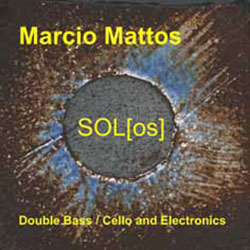The relationship between the cello and double bass isn’t quite as straightforward as it might seem. More first cousins than siblings—the double bass is thought to derive from the old viols, while the cello is firmly within the violin family—their resemblances, though deep, are balanced by their distinct differences. Their pitch ranges overlap significantly, but diverge just as significantly at the upper and lower ends; even where they coincide the double bass’s thicker and longer strings make for a darker overtone profile. And, the differences in their tunings—the double bass tuned to fourths, the cello tuned to fifths—make them handle very differently and make some pitch combinations that are easy on one very difficult on the other. But there are enough similarities between them to make doubling on them an interesting proposition for the right musician.
Marcio Mattos, a native of Brazil now based in England, is one of them. On SOL[OS], a collection of ten performances recorded at various times and venues between the late 1990s and 2010, Mattos plays both double bass and cello, sometimes in combination with electronics but most often alone. Mattos started out on cello before switching to guitar in order to play bossa nova while still in his teens. While playing in bossa nova and jazz bands he became interested in double bass, which he largely taught himself how to play. A change of interest led him to contemporary composed and improvised music and a subsequent move to Europe; during this time he became reacquainted with the cello, albeit from a new perspective.
As the music on SOL[OS] makes clear, Mattos sees double bass and cello as complementary instruments and in some sense as extensions of each other. And perhaps, as when he says he feels the cello is “the bit of the bass that was missing,” even as some kind of single, composite instrument in which each half is in need of the other to complete it. Certainly there is a consistency in the way that Mattos approaches both instruments, most immediately heard in the percussive pizzicato attack that allows him to exploit the generic features shared by both instruments—the vertical orientation of the instrument relative to the performer, the layout of strings accessible both above and below the bridge, the impact characteristics of long strings against similar fingerboards. This is a reminder that there is a substantial area in which a technique effective for one of the two instruments is transposable, with more or less minor modifications, to the other. This would seem to be especially the case with extended techniques, which Mattos employs to emphasize the sheer thingness of both large instruments, taking a tactile, directly hands-on position in relation to them.
This is particularly true of the double bass performances. With the exception of the long final track for double bass and electronics, the bass pieces largely foreground the response of the strings to the impact of fingers, hands or objects. Mattos tends to favor a rapid pizzicato, sometimes on muted strings, although on Filaments he turns to the instrument’s capacity for introversion with a series of moody chords. Of the solo cello pieces Saros also features quick plucking and strumming, while on Spicules Mattos obtains a steel drum-like sound. The Diamond Ring, an arco excursion for solo cello, is an essay in varied bow articulations.
Three of the performances add electronics to cello, while one adds them to double bass. Here Mattos allows the electronics to introduce into the acoustic sounds a degree of creative self-estrangement by virtue of granulation and other varieties of processing. The longest and most recent track in the collection, 2010’s Prominence for double bass and electronics, lets him develop the rapport between the instrument and its electronic shadow to its fullest extent. The full-bodied sound of the acoustic instrument underwrites the processed sounds that hover about it like a ghost image, retaining its basic profile while distorting the details of frequency, duration and dynamics.







